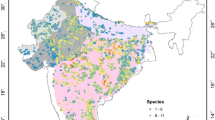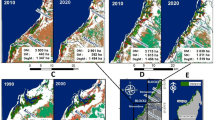Abstract
We examined the capability of hyperspectral imagery to map habitat types of under-storey plants in a moist tall grassland dominated by Phragmites australis and Miscanthus sacchariflorus, using hyperspectral remotely-sensed shoot densities of the two grasses. Our procedure (1) grouped the species using multivariate analysis and discriminated habitat types (species groups) based on P. australis and M. sacchariflorus shoot densities, (2) used estimated shoot densities from hyperspectral data to draw a habitat type map, and (3) analyzed the association of threatened species with habitat types. Our identification of four habitat types, using cluster analysis of the vegetation survey coverage data, was based on P. australis and M. sacchariflorus shoot density ratios and had an overall accuracy of 77.1% (kappa coefficient = 0.71). Linear regression models based on hyperspectral imagery band data had good accuracy in estimating P. australis and M. sacchariflorus shoot densities (adjusted R 2 = 0.686 and 0.708, respectively). These results enabled us to map under-storey plant habitat types to an approximate prediction accuracy of 0.537. Among the eight threatened species we examined, four exhibited a significantly biased distribution among habitat types, indicating species-specific habitat use. These results suggest that this procedure can provide useful information on the status of potential habitats of threatened species.






Similar content being viewed by others
References
Abul-Fatih HA, Bazzaz FA (1979) The biology of Ambrosia trifida L. I. Influence of species removal on the organization of the plant community. New Phytol 83:813–816. doi:10.1111/j.1469-8137.1979.tb02312.x
Aksenova AA, Onipchenko VG (1998) Plant interactions in alpine tundra: 13 years of experimental removal of dominant species. Ecoscience 5:258–270
Allen EB, Forman RTT (1976) Plant species removals and old-field community structure and stability. Ecology 57:1233–1243. doi:10.2307/1935047
Arscott DB, Tockner K, van der Nat D, Ward JV (2002) Aquatic habitat dynamics along a braided alpine river ecosystem (Tagliamento River, Northeast Italy). Ecosystems (N Y, Print) 5:802–814
Blackburn GA (1998) Quantifying chlorophylls and carotenoids at leaf and canopy scales: an evaluation of some hyperspectral approaches. Remote Sens Environ 66:273–285. doi:10.1016/S0034-4257(98)00059-5
Burnham KP, Anderson DR (2002) Model selection and multimodel inference: a practical information-theoretic approach, 2nd edn. Springer, New York
Cliff AD, Ord JK (1981) Spatial processes: models and applications. Pion, London
Cochrane MA (2000) Using vegetation reflectance variability for species level classification of hyperspectral data. Int J Remote Sens 21:2075–2087. doi:10.1080/01431160050021303
Denslow JS (1985) Disturbance-mediated coexistence of species. Academic Press, New York
Edyvane KS (1999) Coastal and marine wetlands in Gulf St. Vincent, South Australia: understanding their loss and degradation. Wetlands Ecol Manage 7:83–104. doi:10.1023/A:1008481228129
Environmental Agency of Japan (2007) Red List of threatened plants of Japan. http://www.env.go.jp/press/file_view.php?serial=9947&hou_id=8648 (in Japanese). Cited 25 Jan 2009
Ferrier S (2002) Mapping spatial pattern in biodiversity for regional conservation planning: where to from here? Syst Biol 51:331–363. doi:10.1080/10635150252899806
Fowler N (1981) Competition and coexistence in a North Carolina grassland II. The effects of the experimental removal of species. J Ecol 69:843–854. doi:10.2307/2259640
Galvão LS, Filho WP, Abdon MM, Novo EMML, Silva JSV, Ponzoni FJ (2003) Spectral reflectance characterization of shallow lakes from the Brazilian Pantanal wetlands with field and airborne hyperspectral data. Int J Remote Sens 24:4093–4112. doi:10.1080/0143116031000070382
Gibbs JP (2000) Wetland loss and biodiversity conservation. Conserv Biol 14:314–317. doi:10.1046/j.1523-1739.2000.98608.x
Guisan A, Zimmermann NE (2000) Predictive habitat distribution models in ecology. Ecol Modell 135:147–186. doi:10.1016/S0304-3800(00)00354-9
Guisan A, Broennimann O, Engler R, Vust M, Yoccoz NG, Lehmann A, Zimmermann NE (2006) Using niche-based models to improve the sampling of rare species. Conserv Biol 20:501–511. doi:10.1111/j.1523-1739.2006.00354.x
Hanley JA, McNeil BJ (1982) The meaning and use of the area under a receiver operating characteristic (ROC) curve. Radiology 143:29–36
Haslam SM (1972) Phragmites communis Trin. J Ecol 60:585–610. doi:10.2307/2258363
Hils MH, Vankat JL (1982) Species removals from a first-year old-field plant community. Ecology 63:705–711. doi:10.2307/1936791
Jäkäläniemi A, Tuomi J, Siikamäki P (2006) Conservation of species in dynamic landscapes: divergent fates of Silene tatarica populations in riparian habitats. Conserv Biol 20:844–852. doi:10.1111/j.1523-1739.2006.00348.x
Keddy PA (2000) Wetland ecology: principles and conservation. Cambridge University Press, Cambridge
Kokaly RF, Despain DG, Clark RN, Livo KE (2003) Mapping vegetation in Yellowstone National Park using spectral feature analysis of AVIRIS data. Remote Sens Environ 84:437–456. doi:10.1016/S0034-4257(02)00133-5
Legendre P, Legendre L (1998) Numerical ecology, 2nd edn. Elsevier Science, Amsterdam
Löbel S, Snäll T, Rydin H (2006) Metapopulation processes in epiphytes inferred from patterns of regional distribution and local abundance in fragmented forest landscapes. J Ecol 94:856–868. doi:10.1111/j.1365-2745.2006.01114.x
Lu S, Funakoshi S, Shimizu Y, Ishii J, de Asis AM, Ajima M, Washitani I, Omasa K (2006) Estimation of plant abundance and distribution of Miscanthus sacchariflorus and Phragmites australis using matched filtering of hyperspectral image. Eco-Engineering 18:65–70
Lu S, Oki K, Shimizu Y, Omasa K (2007) Comparison between several feature extraction/classification methods for mapping complicated agricultural land use patches using airborne hyperspectral data. Int J Remote Sens 28:963–984. doi:10.1080/01431160600771561
McCune B, Grace JB (2002) Analysis of ecological communities. MjM Software, Gleneden Beach
McCune B, Mefford MJ (1999) Multivariate analysis of ecological data, Vers 4.20. MjM Software, Gleneden Beach
Mertes LAK (2002) Remote sensing of riverine landscapes. Freshw Biol 47:799–816. doi:10.1046/j.1365-2427.2002.00909.x
Ministry of Land, Infrastructure and Transport of Japan (2000) Lake and Wetland Survey of Geographical Survey Institute (in Japanese). http://www1.gsi.go.jp/geowww/lake/index.html
Moilanen A, Hanski I (1998) Metapopulation dynamics: effects of habitat quality and landscape structure. Ecology 79:2503–2515
Mutanga O, Skidmore AK, Prins HHT (2004) Predicting in situ pasture quality in the Kruger National Park, South Africa, using continuum-removed absorption features. Remote Sens Environ 89:393–408. doi:10.1016/j.rse.2003.11.001
Ohmann JL, Gregory MJ (2002) Predictive mapping of forest composition and structure with direct gradient analysis and nearest-neighbor imputation in coastal Oregon USA. Can J For Res 32:725–741. doi:10.1139/x02-011
Ohwada M, Ogura H (1996) A floristic study of the Watarase retarding basin. Bull Tochigi Pref Mus 13:31–108 In Japanese with English abstract
Ozesmi SL, Bauer ME (2002) Satellite remote sensing of wetlands. Wetlands Ecol Manage 10:381–402. doi:10.1023/A:1020908432489
R Development Core Team (2006) R: a language and environment for statistical computing. R Foundation for Statistical Computing, Vienna
Richards K, Brasington J, Hughes F (2002) Geomorphic dynamics of floodplains: ecological implications and a potential modelling strategy. Freshw Biol 47:559–579. doi:10.1046/j.1365-2427.2002.00920.x
Rosenfield GH, Fitzpatrick-Lins K (1986) A coefficient of agreement as a measure of thematic classification accuracy. Photogramm Eng Rem S 52:223–227
Schmidt KS, Skidmore AK (2003) Spectral discrimination of vegetation types in a coastal wetland. Remote Sens Environ 85:92–108. doi:10.1016/S0034-4257(02)00196-7
Schmidtlein S, Sassin J (2004) Mapping of continuous floristic gradients in grasslands using hypersperctral imagery. Remote Sens Environ 92:126–138. doi:10.1016/j.rse.2004.05.004
Shevtsova A, Ojala A, Neuvonen S, Vieno M, Haukioja E (1995) Growth and reproduction of dwarf shrubs in a subarctic plant community: annual variation and above-ground interactions with neighbours. J Ecol 83:263–275. doi:10.2307/2261565
Sinclair ARE, Hik DS, Schmitz OJ, Scudder GGE (1995) Biodiversity and the need for habitat renewal. Ecol Appl 5:579–687. doi:10.2307/1941968
Thenkabail PS, Smith RB, Pauw ED (2000) Hyperspectral vegetation indices and their relationships with agricultural crop characteristics. Remote Sens Environ 71:158–182. doi:10.1016/S0034-4257(99)00067-X
Turner W, Spector S, Gardiner N, Fladeland M, Sterling E, Steininger M (2003) Remote sensing for biodiversity science and conservation. Trends Ecol Evol 18:306–314. doi:10.1016/S0169-5347(03)00070-3
Washitani I (2001) Plant conservation ecology for management and restoration of riparian habitats of lowland Japan. Popul Ecol 43:189–195. doi:10.1007/s10144-001-8182-8
Whitehead PJ, Wilson BA, Bowman DMJS (1990) Conservation of coastal wetlands of the Northern Territory of Australia: the Mary River floodplain. Biol Conserv 52:85–111. doi:10.1016/0006-3207(90)90119-A
Yamasaki S (1990) Population dynamics in overlapping zones of Phragmites australis and Miscanthus sacchariflorus. Aquat Bot 36:367–377. doi:10.1016/0304-3770(90)90053-N
Yamasaki S, Tange I (1981) Growth responses of Zizania latifolia, Phragmites australis and Miscanthus sacchariflorus to varying inundation. Aquat Bot 10:229–239. doi:10.1016/0304-3770(81)90025-5
Acknowledgments
We thank Dr. Miho (Ajima) Nishihiro, Dr. Taku Kadoya, Dr. Shin-ichi Takagawa, Dr. Jun Nishihiro, and Mr. Akira Yoshioka of the University of Tokyo and Mr. Masumi Ohwada for field assistance and advice on data analyses. We also thank two anonymous reviewers for valuable comments on an earlier version of the manuscript.
Author information
Authors and Affiliations
Corresponding author
Rights and permissions
About this article
Cite this article
Ishii, J., Lu, S., Funakoshi, S. et al. Mapping potential habitats of threatened plant species in a moist tall grassland using hyperspectral imagery. Biodivers Conserv 18, 2521–2535 (2009). https://doi.org/10.1007/s10531-009-9605-7
Received:
Accepted:
Published:
Issue Date:
DOI: https://doi.org/10.1007/s10531-009-9605-7




